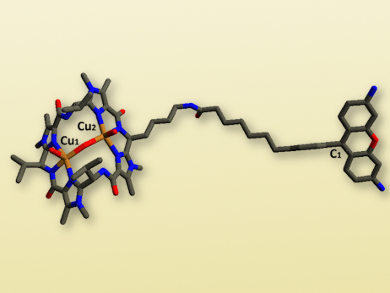Patellamides are cyclic pseudo-octapeptides originally extracted from the sea squirt Lissoclinum patella. They are produced by the squirt’s blue-green algae symbiont, Prochloron. Due to the high concentration of CuII in these blue-green algae, it was believed that patellamides form a dinuclear complex with CuII. The complex was widely studied in vitro, showing remarkable pH-dependent enzymatic activity as a phosphatase or carbonic anhydrase at pH 7–8, and as a glycosidase at pH 10–11. However, its role within the cellular environment had not been studied extensively.
Peter Comba, University of Heidelberg, Germany, and colleagues have synthesized model patellamides (H4pat) and conjugated them to a fluorescent dye (Atto550). The team then used fluorescence spectroscopy and fluorescence lifetime measurements to look at the effect of CuII ion complexation on the photophysical properties of the H4pat-Atto550 conjugates. The team found that CuII quenches the fluorescence of H4pat-Atto550.
The researchers then showed with confocal fluorescence microscopy and flow cytometry that Prochloron cells take in H4pat-Atto550. Incubating H4pat-Atto550 with CuII lowers the fluorescence intensity inside the Prochloron cells. This indicates the presence of CuII-H4pat-Atto550 complexes (example pictured) within the cells. They can be disrupted by a competitive CuII-chelator like cyclam.
This study is the first attempt into understanding the biological role of CuII-patellamides inside the Prochloron cells. It could serve as a start for further exploration of its cellular catalytic function.
- Is CuII Coordinated to Patellamides inside Prochloron Cells?,
Peter Comba, Annika Eisenschmidt, Lawrence R. Gahan, Dirk-Peter Herten, Geoffrey Nette, Gerhard Schenk, Martin Seefeld,
Chem. Eur. J. 2017.
DOI: 10.1002/chem.201700895
